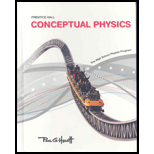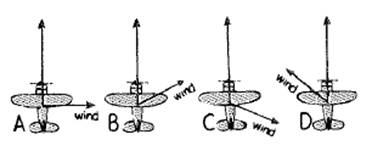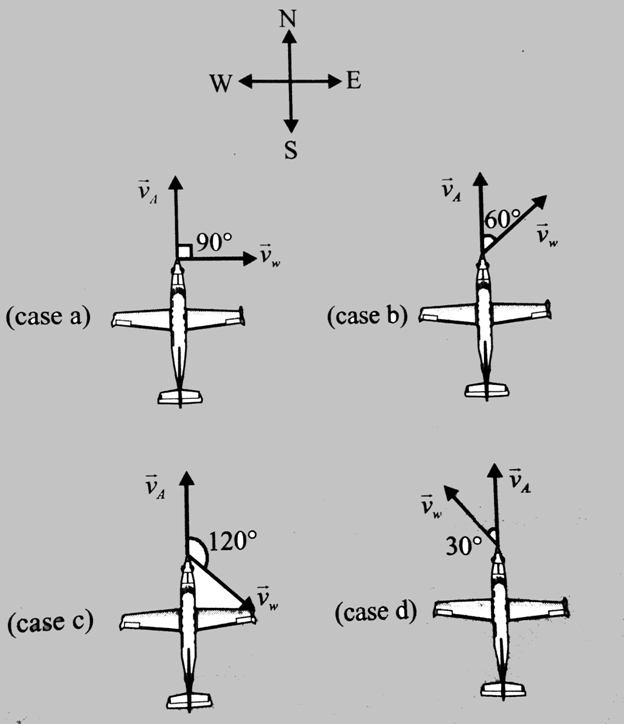
Concept explainers
The airplane is blown off course by wind in the directions shown. Use the parallelogram rule and rank from highest to lowest the resulting speed across the ground.

To rank: The airplanes resulting speed from highest to lowest.
Answer to Problem 17A
D >B> A> C
Explanation of Solution
Given:
Airplanes along with wind direction are shown below.

Formula used:
According to parallelogram law, if two vectors are represented along the two sides of the parallelogram then their vector sum represents the resultant of two vectors in terms of magnitude and direction.
Calculation:
Consider the figure shown below.

 is the vector component of wind velocity and
is the vector component of wind velocity and  is the vector component of airplane velocity. If by directions provided in the question, angles are calculated. Then, it is quite obvious the airplane in which the wind direction is in the direction of airplane or nearby will move faster across the ground and the one in which the wind velocity is exactly opposite or in nearby directions will move slower.
is the vector component of airplane velocity. If by directions provided in the question, angles are calculated. Then, it is quite obvious the airplane in which the wind direction is in the direction of airplane or nearby will move faster across the ground and the one in which the wind velocity is exactly opposite or in nearby directions will move slower.
In the above diagram, wind velocity and airplane velocity is represented with directions. The airplane is moving in the North direction and accordingly wind direction is varying in each case. According to parallelogram law, the resultant of two vectors is the sum of their vectors concerning their directions and magnitude.
So, D will move fastest as it has minimum angle compared to airplane direction. Then, C then A. But, B will be the last one because the wind direction is moving towards South-East, which is quite opposite to the direction in which the airplane is moving.
Conclusion:
Therefore, ranking of fastest to slowest airplane is D> B> A> C.
Chapter 5 Solutions
Conceptual Physics: The High School Physics Program
Additional Science Textbook Solutions
Sears And Zemansky's University Physics With Modern Physics
College Physics
University Physics (14th Edition)
Life in the Universe (4th Edition)
Conceptual Physical Science (6th Edition)
College Physics: A Strategic Approach (4th Edition)
 College PhysicsPhysicsISBN:9781305952300Author:Raymond A. Serway, Chris VuillePublisher:Cengage Learning
College PhysicsPhysicsISBN:9781305952300Author:Raymond A. Serway, Chris VuillePublisher:Cengage Learning University Physics (14th Edition)PhysicsISBN:9780133969290Author:Hugh D. Young, Roger A. FreedmanPublisher:PEARSON
University Physics (14th Edition)PhysicsISBN:9780133969290Author:Hugh D. Young, Roger A. FreedmanPublisher:PEARSON Introduction To Quantum MechanicsPhysicsISBN:9781107189638Author:Griffiths, David J., Schroeter, Darrell F.Publisher:Cambridge University Press
Introduction To Quantum MechanicsPhysicsISBN:9781107189638Author:Griffiths, David J., Schroeter, Darrell F.Publisher:Cambridge University Press Physics for Scientists and EngineersPhysicsISBN:9781337553278Author:Raymond A. Serway, John W. JewettPublisher:Cengage Learning
Physics for Scientists and EngineersPhysicsISBN:9781337553278Author:Raymond A. Serway, John W. JewettPublisher:Cengage Learning Lecture- Tutorials for Introductory AstronomyPhysicsISBN:9780321820464Author:Edward E. Prather, Tim P. Slater, Jeff P. Adams, Gina BrissendenPublisher:Addison-Wesley
Lecture- Tutorials for Introductory AstronomyPhysicsISBN:9780321820464Author:Edward E. Prather, Tim P. Slater, Jeff P. Adams, Gina BrissendenPublisher:Addison-Wesley College Physics: A Strategic Approach (4th Editio...PhysicsISBN:9780134609034Author:Randall D. Knight (Professor Emeritus), Brian Jones, Stuart FieldPublisher:PEARSON
College Physics: A Strategic Approach (4th Editio...PhysicsISBN:9780134609034Author:Randall D. Knight (Professor Emeritus), Brian Jones, Stuart FieldPublisher:PEARSON





